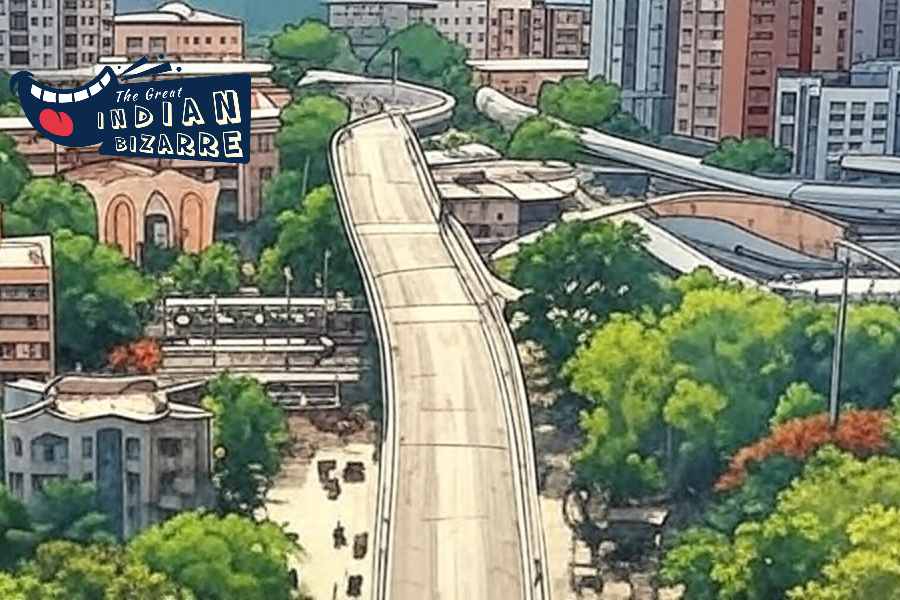
A drive on railway tracks

Roads are way too mainstream for a drive. So, this woman chose the railway tracks to put her skillset to the test.
Vomika Sony, a 34-year-old techie from Lucknow, drove onto the railway tracks near Shankarpalli in Telangana, disrupting train services for at least an hour at 7 in the morning.
She thwarted attempts by villagers to stop her by brandishing an iron rod. The helpless locals eventually alerted railway officials, following which train services on the route were halted as a precautionary measure.
Witnesses and police reported that Sony stepped out of the car with the iron rod and allegedly attacked officials trying to detain her. She also hurled stones at the bystanders.
She was eventually taken into custody by the cops. Apparently, she was under the heavy influence of alcohol.
However, her family told the police she had been suffering from severe depression after losing her job at an IT firm.
A video of her “long drive” has since gone viral on social media, with users flooding the comments section with reactions.
One said, “@KiaInd should give her a discount for making it popular.”
One gamer quipped, “Huh big deal... I've always done this...in GTA.”
Water makes matters worse in MP

Oil and water generally don’t mix, but when they did, they managed to get Madhya Pradesh chief minister Mohan Yadav’s convoy towed.
The CM was on his way to Ratlam for a skill development conclave. To ensure a smooth ride, the convoy stopped at a petrol pump to fill tanks. But instead of power-packed diesel, the cars got a surprise cocktail of diesel seasoned with water.
As expected, the convoy barely made it a few metres before giving up.
Mechanics rushed in to check the vehicles, which looked perfectly fine on the outside. But once the fuel tanks were opened, the truth floated up (quite literally).
Turns out, another truck driver who fuelled up at the same pump also met the same fate.
The authorities swiftly sealed the gas station and ordered a probe.
However, the owner of the station denied adulteration charges. “It is possible that rainwater leaked into the underground tank due to heavy rainfall. This is not a case of adulteration but an unfortunate incident,” he was quoted as saying by news agencies.
Seeking justice from toilet seat

It is one of the peculiar blessings of modern life that we can now conduct almost everything — banking, shopping, arguing with strangers — from the comfort of our own lavatories. And now, thanks to one enterprising man in Gujarat, you can add court appearances to that list.
On June 20, a gentleman — under the alias 'Samad Battery'— decided to attend a Gujarat high court hearing via Zoom from the toilet seat.
The video, just under a minute long and now widely shared, begins innocently enough. We see a close-up of Mr Battery’s neck, earphones snugly in place, giving the reassuring impression that he’s simply another litigant embracing the ease of digital justice. But then, in a cinematic flourish Hitchcock himself might have admired, the camera tilts downward. There he is, seated on the commode, phone resting dutifully on the bathroom floor. Moments later, he proceeds to clean himself. Yes, that kind of cleaning.
Meanwhile, the court carries on. An advocate in the courtroom makes his arguments, blissfully unaware that his respondent is wiping mid-hearing.
According to Bar and Bench, the man was the original complainant in a cheque bounce case and was appearing as a respondent in a matter concerning the quashing of the FIR. The court was informed of a mutual settlement. The FIR was quashed. Everyone moved on. Except the internet, which naturally did not.
This isn’t the first such incident to grace the hallowed e-corridors of the Gujarat High Court. In March, a man was fined Rs 2 lakh and given community service for attending proceedings from his lavatory. The month before that, another was fined Rs 25,000 for lounging in bed during a hearing. There is, it seems, no end to how people can misuse a webcam.
Too early for duty

In a small town in eastern Uttar Pradesh, a young man became a police constable for five days. On the fifth day of his training, he tried to quit.
The trouble began, as most trouble does in this part of the world, at 4 in the morning.
That’s when he was expected to rise and shine for training. This, he found, was not only unreasonable but physically impossible. For years, he had disciplined himself — very effectively, it must be said — to sleep until 8am, sometimes longer. And now, within days of joining the force, he was being made to run around like a military-grade alarm clock.
So he did what any overwhelmed recruit would do: he took his father along and marched straight into the Superintendent of Police’s office to resign.
His father, looking remarkably composed for someone accompanying a grown man on a mission to avoid exercise, explained the situation helpfully. “He wanted to become a teacher,” he said. “He is used to studying all day. The physical rigours of police training did not excite him much.”
Quite understandable. One moment you’re dreaming of chalk dust and exam invigilation, and the next, someone’s yelling at you to do push-ups in the dark.
At the SP office in Deoria, the young man asked to see Superintendent Vikrant Veer. Instead, he met Dr Mahendra Kumar, the public relations officer, who, to his credit, took the situation in his stride.
One imagines the recruit sitting there, eyes half open, body aching, wondering how he went from a government appointment letter to regretting his entire life before sunrise.
But Dr Mahendra wasn’t ready to give up. He gave the recruit a counselling session, which is the official term for telling someone not to be silly.
And just like that, the constable changed his mind. He didn’t submit his resignation. He didn’t meet the SP. He simply got up and left — perhaps still sleepy, but now committed.
Across Uttar Pradesh, new constables are undergoing what is known as the Joint Training Course (JTC). After one month, they’ll head to other centres for a nine-month advanced course, followed by official postings.
With any luck, some of those postings won’t involve waking up at 4am.
Democracy swims in Machher-Jhol

It was democracy, Bengali-style. No manifestos. Just fish.
At IIT Kharagpur, when students voted for their elected board this year, the ballot looked less like a poll sheet and more like a Bengali lunch menu. Each candidate wasn’t represented by a fish. Yes, fish.
So you had Hilsa (Bhattacharya), Chitol (Datta), Mrigel (Das), Bhetki (Basak), Katla (Dey), Rohu (Rao), and Chandana (Ghosh).
At least one voter must have stood confused at the booth, torn between his loyalty to Hilsa and his taste for Chitol Maachher Muitha.
The symbolism was lost on no one because of the timing.
As IIT-Kharagpur proudly declared it has jumped seven spots globally in the 2026 QS World University Rankings (now at 215th), voters were busy debating whether Chandana was even a valid fish and if Rohu has electoral appeal beyond lunch tables.
The ballots reportedly had no pictures, only names. The Telegraph Online did not reach out to the campaigners because we felt it was a fishy affair.
It’s also unclear who won. Because in the Bengali scheme of things, once Hilsa shows up, results don’t matter.
28 years, 3 lanes, zero logic: Mumbai’s foozled flyover

After 28 years of patient planning and snail-paced construction, Mumbai has finally unveiled its latest urban marvel, the Vikhroli flyover.
And in true desi fashion, it’s already headed straight into the Hall of Bizarre.
Built over nearly three decades, the flyover boasts not a smart lane system or futuristic design, but three lanes of pure democratic chaos. No divider. Just vibes.
Here’s how it works: One lane for this side, one for that side, and the third? A no-man’s-land where east meets west, Maruti meets Mahindra, and tempers meet boiling point.
Naturally, traffic snarls up within minutes, and desperate drivers try dodging the mess by squeezing into the farthest lane — thereby ensuring total blockage. Like clockwork.
And just when you think it can't get any better, urban planners are reportedly considering adding a divider. Soon. After some accidents, public outrage, a few memes, and ideally one viral video involving an angry scooterist and a Fortuner.
You waited 28 years for this? Don’t worry — at this rate, the renovation will be ready by 2053.
(Compiled by Sohini Paul, Sriroopa Dutta, Subharup Dasharma and Payel Das)







